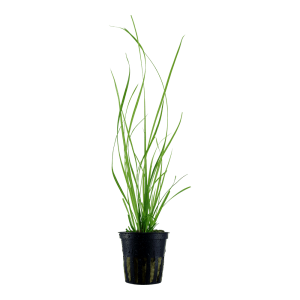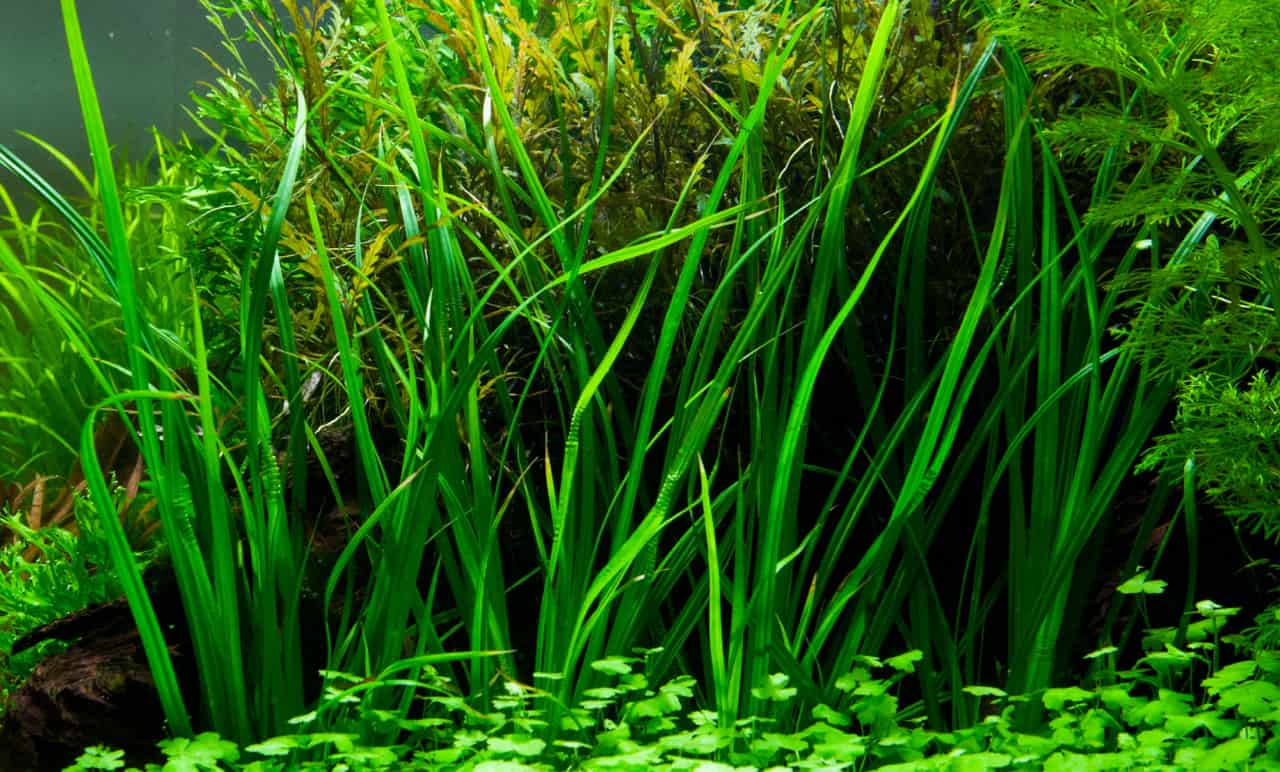Background
There are 900 species of plants in the genus Cyperus, and a lot is accessible in the water garden trade. However, there are just a few plant species in this genus that can grow submersed. Cyperus helferi is among them, and the first one used in an underwater landscape in a submerged state.
This aquatic plant is from Cyperaceae family which Takashi Amano introduced in Aquascape. He was the famous Japanese aquarium enthusiast who has authored Nature Aquarium World series. The book showcased his subtle and minimalist style in his design, the Iwagumi Aquascape, of which this plant played an important part.
Where it Originated From
Cyperus helferi plant species hail from Thailand, Southeast Asia. This plant can grow both immersed or submersed in its known Biotope. Left in the wild, you will see these plants on the banks of stagnant or slow-flowing water.
Data Sheet
- Tank size: 20 - 35 cm (7.87 - 13.78 inch)
- Temperature: 20-27°C
- pH level: 5.5–7.5
- Water hardness: 1-20°dH
- Light conditions: Medium–Strong
- Substrate: Fine gravel
- Growth rate: Slow
- Difficulty: Medium (not suitable for beginners)
- Usage: Background, Midground, Specimen
What's so Special?
 This aquatic plant can produce 50 long and narrow leaves that grow from its center or rosette. The bush arcs because it cannot withstand the steady flow of water. Its roots are unlike the other rosette-style plants. Cyperus helferi roots have poor growth pattern.
This aquatic plant can produce 50 long and narrow leaves that grow from its center or rosette. The bush arcs because it cannot withstand the steady flow of water. Its roots are unlike the other rosette-style plants. Cyperus helferi roots have poor growth pattern.
Cyperus helferi can grow up to 40 cm with a leaf width of 5-7 mm. It can grow underwater, as a floater plant, or as a potted garden plant, making it more popular to fish keeping trade and hobby.
Difficulty in Keeping
Aquatic plants need a period of change when brought to another environment. This acclimatization is the difficulty any aquarium enthusiast used to experience.
Fragile plants, amphibious or not pass through this stage. When they get over it and provided conditions, they continue their growth process and propagate.
Cyperus helferi is not hard to maintain. It is a plant in the league of delicate species that adjust with a long acclimatization period. Therefore it makes it impossible for the novice to handle it as beginner plant.
Few leaves may rot and melt, decreasing the bush density. Experienced hobbyists knew this to happen in some aquatic plants, but that’s the usual stage that a novice does not understand and might get discouraged.
A bit of research will help. If your passion is aquascape, you are always enthusiastic about enriching your knowledge.
Caring for the Plant
Cyperus helferi prefers a slow to medium water current when housed in an aquarium. It must not differ from the condition they are familiar with in the wild. Remember, the plant can even survive in standstill waters.
Cyperus helferi is not demanding with water hardness. It can grow well in soft and medium water hardness. It dwells in tanks with an efficient filtration system or through reverse osmosis.
Its slow growth rate paved the way for algae to appear on its leaves. Therefore, provide an excellent bio-filtration to control the level of ammonia in the water.
Regarding illumination, we know that direct sunlight will make them thrive whether you find them afloat or underwater. So, in your little environment, you can gauge its light preference on moderate lighting first, then adjusting by and by too intense, like 2-4 watts/gallon or more. This setting is just enough to generate a cooler temperature below 80°F of which is desirable for this fragile plant.
Although caring for this plant doesn’t require CO2 injection, it will be beneficial if there is. It can contribute to its robust and rapid growth.
Cyperus helferi may grow more than you expected. Some hobbyists like a luxurious look though but others prefer it controlled for a shallower tank. If you want to maintain its longer leaves, house the plant in a deeper aquarium.
Cut off the leaves if they grow out of proportion. You dislike a jungle look in your tank because Cyperus helferi is best to use in a minimalist-themed aquascape. Trim it with a pair of scissors and those cuttings won’t grow any longer, they’ll rot and die over time.
Nutrients
Trace minerals are essential to aquatic plants. These are sufficient in the wild where you can find the organic sources of all essential nutrients. Therefore plants thrive in no time in its natural habitat.
During captivity, you should provide your Cyperus helferi with some abundant additives to attain more stable growth. You may use ground fertilizer or clay soil under its roots for additional benefits.
Enriching nutrients like NPK (Nitrogen, Phosphate, and Potassium) and the supplementing micronutrients or trace minerals are essential to the plant.
Cyperus helferi won’t suffer much with insufficient nutrient supply. A dedicated aquarist, however, will see that he meets every requirement so the plant will show the ideal growth. They make sure they follow the suggested amount of supplements per gallon of water the tank holds.
Choose a small-grained substrate rich with Kalium, Nitrates, and Phosphate. Instead of these in the substrate, you will need more fertilization methods.
How to propagate Cyperus helferi?
Cyperus helferi comes in potting soil from the aquaria farms. You might encounter some problems during its transition from pot to the tank.
Some leaves won’t survive and wilt, but the plant will recover soon. This period is acclimatization.
Even experienced aquarists are familiar with this stage, so don’t worry; patience is the key. The plant will get over this period and will proceed with its growth.
When everything seems to be working well, the leaves will spread at a slow pace. Occasional trimmings will make it appear dense.
If you don't shorten your Cyperus helferi, it might cover other companion plants and cause them a stunted growth. Therefore, it is better to house it in a tank with a minimum water of 100 liters.
This bush can grow on its own and can propagate when the main plant develops adventitious plantlets at its base.
Because of its adventitious growth pattern, the plants sprout not from the roots but on its cut leaves and underground stems.
Make sure tiny roots are present on these plantlets and have developed leaflets before you divide or separate them from the main plant.
You need to have patience; it always takes time to gather plantlets suitable to propagate.
Other ways to propagate this plant is by trimming the top part and replanting the cuttings upside down in the substrate.
Best Tank Position for Cyperus helferi
If you want a grass-like look in your tank, Cyperus helferi is the right choice. Its long leaves waving in the water column is not only pleasing but relaxing.
The shape of its leaves in a fluffy bush is an eye-catcher when it sways in the current. It’s like moving in slow motion, and somehow it conveys a message “Relax, no need to rush.”
One reason we keep an aquarium at home is its calming effect on us. Therefore, we should know the right placement of plants to create a balance and contrast with all the biota in it.
Cyperus helferi can make a full backdrop when you plant multiple pieces near the moving water. However, you can decorate the tank’s midsection with this plant combined with the other shorter plants.
If you want to create underwater pathways or backside, Cyperus helferi can add drama to the theme. Make sure these plants have equal needs.
Suggested Combinations with Cyperus helferi
These plants I have grouped for decorating purpose is often a choice in the aquascape. They have the same growth requirements and versatility, so it will be easier to maintain a bunch of plants all together in one community tank.
Combination Set 1
- Cyperus helferi
- Anubias nana
- Pogostemon helferi
- Cryptocoryne Petchii
- Ludwigia glandulosa
- Eanunculus inundates
- Eleocharis parvula
Combination Set 2
- Cyperus helferi
- Helanthum Quadricostatus
- Eleocharis acicularis
- Eriocaulon cinereum
- Elatine hydropiper
Combination Set 3
- Cyperus helferi
- Staurogyne repens
- Microsorum pteropus
- Pogostemon Erectus
- Anubias petite
- Rotala green
- Bolbitis heudelotii
- Hygrophila Araguaia
Combination Set 4
- Cyperus helferi
- Nymphaea lotus
- Limnophila hippuridoides
- Lobelia cardinalis
- Limnophila sessiliflora
- Rotala macrandra
- Crinum calamistratum
- Murdannia keisak
- Bacopa caroliniana
- Pogostemon Erectus
Final Thoughts
Takashi Amano believed that a sole plant-like Cyperus helferi is enough to be distinctive in a minimalist aquarium like the one-plant style of Iwagumi Aquascape.
If you want more plants, limit it from 2 to 3 more specimens and still maintain the concept of minimalism. However, this plant can exude its appeal also in a planted tank provided there is proper placement and contrast to balance the presentation.
Cyperus helferi symbolizes rebirth and prosperity. If you place your aquarium according to the rules of Feng Sui, the plant activates good energy to deliver positive vibes, tranquility, freedom, and good fortune.



